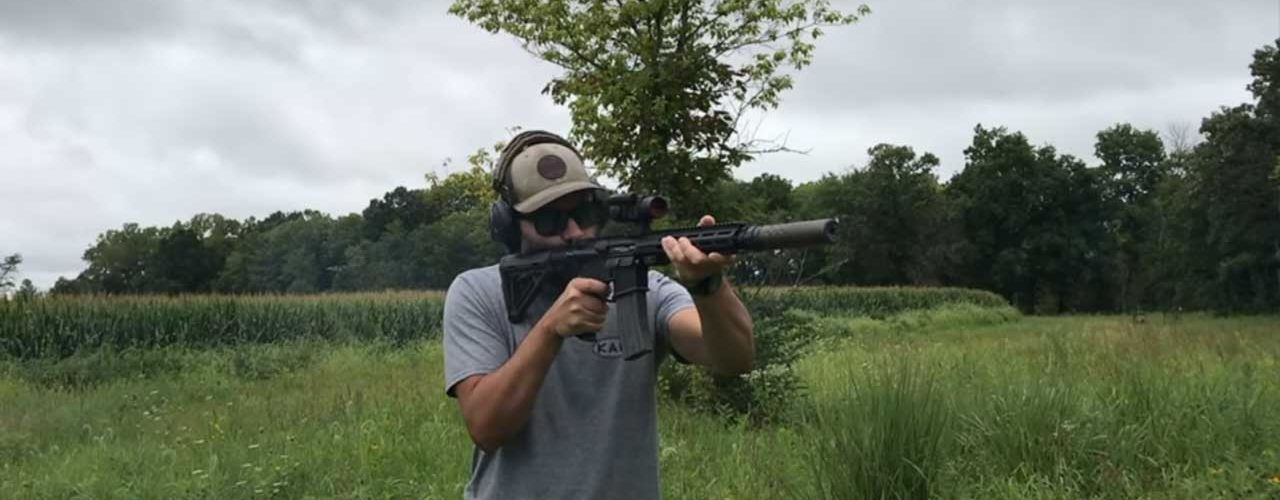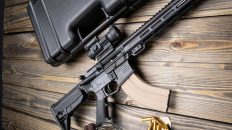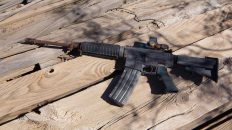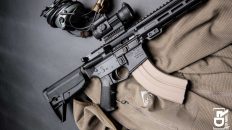Are you torn between the allure of a stealthy whisper or the raw power of a thunderous roar? When it comes to firearms, specifically the popular AR-15, this is a decision many enthusiasts find themselves wrestling with. The choice between using a suppressed or unsuppressed AR-15 can greatly impact everything from noise levels and recoil to accuracy and versatility. In this article, we will dive deep into the advantages and disadvantages of both options, shedding light on factors such as safety, legality, and overall shooting experience. Whether you’re a seasoned shooter or simply curious about the world of firearms, we aim to provide you with the information you need to make an informed decision. Join us as we explore the whisper of suppressed firepower and the raw roar of its unsuppressed counterpart. Prepare to gain valuable insights, dispel myths, and equip yourself with the knowledge to choose the AR-15 that best suits your needs.
What is a suppressed firearm?
Suppressed firearms, also known as silenced firearms, are firearms that have been equipped with a sound suppressor or silencer. These devices are designed to reduce the noise and muzzle flash generated when a firearm is discharged. The primary purpose of a suppressor is to lower the decibel (dB) level of the gunshot, making it less disruptive and more discreet. By using a suppressor, the user can significantly reduce the audible report of the firearm, often making it sound more like a “puff” than a loud “bang.” This feature can be particularly useful in certain situations, such as hunting, target shooting, or tactical operations, where minimizing noise is a priority.
Suppressors work by trapping the expanding gases that are released when a round is fired, slowing down the muzzle velocity and reducing the overall sound signature. They are typically made of durable materials like stainless steel or titanium and are attached to the muzzle of the firearm, either permanently or through a threaded connection. The size and design of the suppressor can affect its effectiveness, with larger suppressors generally providing more sound reduction than smaller ones.
It’s important to note that the use of suppressors is regulated in many countries, and their legality and ownership requirements vary widely. In some jurisdictions, suppressors are considered a restricted or controlled item, requiring additional paperwork, licensing, or even a special permit to own and use. Understanding the local laws and regulations surrounding suppressor ownership and usage is crucial for any firearm enthusiast or user.
Advantages of using a suppressed AR-15
Using a suppressed AR-15 rifle offers several distinct advantages that can make it an attractive choice for various shooting applications. One of the primary benefits is the reduced noise level. By attaching a suppressor to the muzzle of an AR-15, the sound of the gunshot is significantly dampened, often reducing the decibel level to a point where it is no longer considered a hearing hazard. This can be particularly beneficial in situations where noise discipline is crucial, such as hunting or tactical operations, as it allows the shooter to engage targets without drawing unwanted attention or causing discomfort to nearby individuals.
Another advantage of using a suppressed AR-15 is the improved shooting experience. The reduced recoil and muzzle rise associated with a suppressed firearm can enhance accuracy and control, making it easier for the shooter to maintain a steady sight picture and deliver accurate shots. This can be especially advantageous in scenarios where rapid, precise fire is required, such as target shooting competitions or self-defense situations.
Additionally, the use of a suppressor can contribute to the overall safety of the shooting experience. By mitigating the loud noise generated by the firearm, the risk of hearing damage is significantly reduced, allowing the shooter and any nearby individuals to engage in shooting activities without the need for bulky and potentially uncomfortable hearing protection. This can be particularly beneficial in training scenarios or when conducting recreational shooting with family and friends.
Disadvantages of using a suppressed AR-15
While the use of a suppressed AR-15 offers several advantages, there are also some potential drawbacks to consider. One of the primary disadvantages is the added weight and bulk of the suppressor itself. Suppressors can be relatively heavy, ranging from a few ounces to several pounds, depending on their size and design. This additional weight can affect the overall balance and handling of the firearm, potentially making it more cumbersome to maneuver and manipulate, especially during rapid movements or in confined spaces.
Another potential disadvantage of using a suppressed AR-15 is the reduced muzzle velocity. The presence of the suppressor can slightly slow down the projectile as it exits the barrel, resulting in a slight decrease in velocity and potentially impacting the ballistic performance of the ammunition. This can be a consideration for shooters who rely on the high-velocity characteristics of the AR-15 platform for long-range shooting or specific applications.
Furthermore, the use of a suppressor can introduce additional maintenance and cleaning requirements. The internal AR-15 components of the suppressor can accumulate carbon buildup and fouling over time, necessitating regular cleaning and maintenance to ensure optimal performance and reliability. This additional step in the firearm maintenance process can be a consideration for shooters who value convenience and simplicity in their shooting routines.
What is an unsuppressed firearm?
An unsuppressed firearm, also known as a non-suppressed or “naked” firearm, is a firearm that does not have a sound suppressor or silencer attached to it. When a round is fired from an unsuppressed firearm, the loud, distinctive “bang” or report is produced, which is the result of the rapid expansion of gases and the breaking of the sound barrier by the projectile.
The loud report of an unsuppressed firearm can serve several purposes, depending on the context and intended use. In a self-defense or tactical scenario, the loud noise can act as a deterrent, potentially startling or disorienting an attacker. In competitive shooting or hunting applications, the loud report can provide auditory feedback to the shooter, allowing them to better gauge the timing and accuracy of their shots.
However, the loud noise generated by an unsuppressed firearm can also have drawbacks. The high decibel levels can pose a significant risk to the shooter’s and bystanders’ hearing, potentially causing permanent damage if proper hearing protection is not used. Additionally, the loud report can draw unwanted attention in certain situations, making the firearm less suitable for applications where discretion and stealth are desired, such as some types of hunting or tactical operations.
Advantages of using an unsuppressed AR-15
One of the primary advantages of using an unsuppressed AR-15 is the simplicity and ease of use. Without the added complexity of a suppressor, the firearm remains lighter, more compact, and potentially easier to handle, especially in dynamic or fast-paced situations. This can be particularly beneficial for shooters who prioritize mobility, quick target acquisition, and rapid deployment of the firearm.
Another advantage of the unsuppressed AR-15 is the potential for increased muzzle velocity and ballistic performance. The absence of a suppressor can allow the projectile to maintain its full velocity as it exits the barrel, potentially improving the firearm’s long-range accuracy and downrange performance. This can be advantageous for shooters who prioritize long-distance shooting or require the maximum ballistic potential of the AR-15 platform.
Additionally, the use of an unsuppressed AR-15 can be advantageous in certain legal and regulatory environments. In some jurisdictions, the ownership and use of suppressors may be more heavily regulated or even prohibited, whereas the unsuppressed firearm may be subject to fewer restrictions or requirements. This can simplify the legal and administrative aspects of firearm ownership and usage for the shooter.
Disadvantages of using an unsuppressed AR-15
One of the primary disadvantages of using an unsuppressed AR-15 is the significantly higher noise level generated by the firearm. The loud report of an unsuppressed AR-15 can be disruptive, potentially causing discomfort or even hearing damage to the shooter and any nearby individuals if proper hearing protection is not used. This can be a significant drawback in situations where noise discipline is crucial, such as hunting, tactical operations, or even recreational shooting in close proximity to others.
Another potential disadvantage of the unsuppressed AR-15 is the increased muzzle rise and recoil experienced by the shooter. Without the stabilizing effect of a suppressor, the firearm may exhibit more pronounced muzzle rise and recoil, potentially making it more challenging to maintain a stable sight picture and deliver accurate follow-up shots. This can be a consideration for shooters who prioritize precision and control, especially in rapid-fire or dynamic shooting scenarios.
Additionally, the lack of a suppressor can make the unsuppressed AR-15 less versatile in certain applications. For example, in some hunting situations, the loud report of the unsuppressed firearm may startle or spook the intended game, reducing the shooter’s chances of a successful harvest. Similarly, in tactical or stealth-oriented operations, the loud noise generated by the unsuppressed AR-15 can compromise the shooter’s ability to remain undetected and limit their tactical options.
Legal considerations for owning and using suppressed firearms
The legal landscape surrounding the ownership and use of suppressed firearms can be complex and varies greatly depending on the jurisdiction. In many countries, the possession and use of suppressors are subject to specific regulations and requirements, often requiring additional paperwork, licensing, or even special permits.
In the United States, for example, suppressors are classified as “Title II” or “NFA” (National Firearms Act) items, which means that their ownership and transfer are subject to additional federal regulations and restrictions. Individuals wishing to acquire a suppressor must undergo a thorough background check, pay a tax stamp fee, and obtain approval from the Bureau of Alcohol, Tobacco, Firearms, and Explosives (ATF) before they can legally possess the device.
The legal status of suppressors can also vary at the state level, with some states having more permissive laws and others imposing stricter regulations. Some states may require the shooter to obtain a specific permit or license to own and use a suppressed firearm, while others may have outright bans on the possession of suppressors. It is crucial for firearm enthusiasts to thoroughly research and understand the local laws and regulations in their area before acquiring or using a suppressed firearm.
Choosing between suppressed and unsuppressed AR-15 firearms
When it comes to choosing between a suppressed or unsuppressed AR-15, there is no one-size-fits-all solution, as the decision ultimately depends on the shooter’s specific needs, preferences, and the intended use of the firearm. Both options offer distinct advantages and disadvantages, and the choice will often come down to a careful consideration of factors such as noise requirements, ballistic performance, legal considerations, and personal shooting style.
For shooters who prioritize discretion, noise discipline, and the ability to engage targets with a minimal audible signature, the suppressed AR-15 can be an attractive choice. The reduced sound levels can be particularly beneficial in hunting, tactical, or training scenarios where maintaining stealth is crucial. However, the added weight, maintenance requirements, and potential impact on ballistic performance may be drawbacks that some shooters are unwilling to accept.
On the other hand, the unsuppressed AR-15 may be the preferred option for shooters who value simplicity, mobility, and maximum ballistic performance. The lack of a suppressor can make the firearm lighter and more compact, potentially improving handling and target acquisition. Additionally, the unsuppressed AR-15 may be the more practical choice in jurisdictions with stricter regulations or restrictions on the ownership and use of suppressors.
Ultimately, the decision between a suppressed or unsuppressed AR-15 will depend on the individual shooter’s specific needs, priorities, and the legal environment in which they operate. Careful research, hands-on experience, and consultation with knowledgeable firearms experts can help guide the shooter in making the most informed and suitable choice for their particular shooting requirements.
Conclusion
The choice between a suppressed or unsuppressed AR-15 is a complex decision that requires careful consideration of various factors, including noise levels, ballistic performance, legal implications, and personal preferences. Both options offer distinct advantages and disadvantages, and the optimal choice will depend on the shooter’s specific needs and the intended use of the firearm.
For those seeking discretion, noise discipline, and a more comfortable shooting experience, the suppressed AR-15 can be a compelling choice. The reduced sound levels can be particularly beneficial in hunting, tactical, or training scenarios where maintaining stealth is crucial. However, the added weight, maintenance requirements, and potential impact on ballistic performance may be drawbacks that some shooters are unwilling to accept.
On the other hand, the unsuppressed AR-15 may be the preferred option for shooters who prioritize simplicity, mobility, and maximum ballistic performance. The lack of a suppressor can make the firearm lighter and more compact, potentially improving handling and target acquisition. Additionally, the unsuppressed AR-15 may be the more practical choice in jurisdictions with stricter regulations or restrictions on the ownership and use of suppressors.
Ultimately, the decision between a suppressed or unsuppressed AR-15 is a personal one that should be made after careful consideration of the shooter’s specific needs, priorities, and the legal environment in which they operate. By understanding the advantages and disadvantages of both options, firearm enthusiasts can make an informed choice that best suits their shooting requirements and preferences.





Add comment